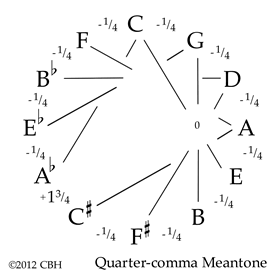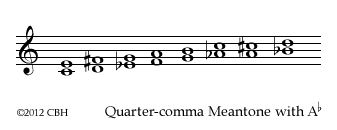Technical Library
TEMPERAMENTS IX: Transposing Quarter-comma Meantone
Entire Contents Copyright © 2013 CBHTechnical LibraryTEMPERAMENTS IX: Transposing Quarter-comma Meantone Entire Contents Copyright © 2013 CBH |
 If you want to play in keys further afield, you can still do so in Quarter-comma
Meantone, but you must be prepared to retune a little, transposing the temperament
somewhat.
If you want to play in keys further afield, you can still do so in Quarter-comma
Meantone, but you must be prepared to retune a little, transposing the temperament
somewhat.
For example, to change all your G♯s to A♭s, determine the a♭ a pure third down from middle c', instead of the g♯ that resulted when you tuned up a pure third from the e. You’ll no longer be able to play in the key of a minor because you’ve lost your G♯ leading note.
 The diagrams show what we have accomplished: See the difference by putting your mouse over either of them and then removing it. Compared to our first incantation,
the dial has really just spun one notch anticlockwise, locating our wolf between
A♭ and C♯. We’ve lost our pure third on top of
E, but gained it on top of A♭ instead.
The diagrams show what we have accomplished: See the difference by putting your mouse over either of them and then removing it. Compared to our first incantation,
the dial has really just spun one notch anticlockwise, locating our wolf between
A♭ and C♯. We’ve lost our pure third on top of
E, but gained it on top of A♭ instead.
You can go one step further if you need to play Pachelbel’s Ciacona in f minor: Change all your C♯s to D♭s, by determining the d♭' a pure third down from f', instead of the c♯' that results when you tune up a pure third from the a.
Some electronic tuning machines like the Korg OT-120 (or the earlier OT-12) give two versions of Quarter-comma Meantone: The standard has an E♭, with a D♯ version provided as an alternative.
There are other possibilities, and perhaps I can excite you to play around
some more while we divert our attention to some meantone variants. Then it will
be time to look at some more well temperaments.
| Pitch nomenclature | |
| Harpsichord Tuning Process | |
| Tuning Bibliography | |
| Technical Library overview | |
| Harpsichords Australia Home Page |